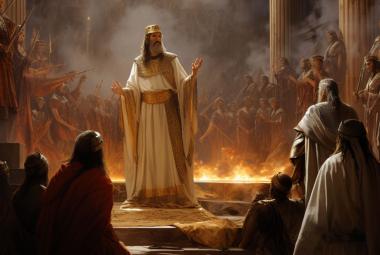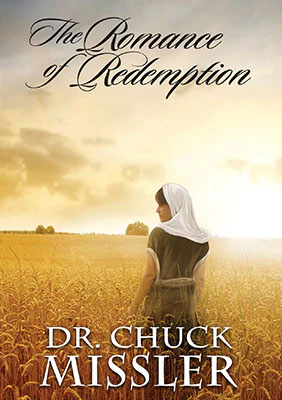On May 23rd our Jewish friends will celebrate the Feast of Shavuot.1 The Book of Ruth is traditionally read on this holiday, also known as the Feast of Pentecost. For a number of reasons, this feast may have far more prophetic relevance than is commonly recognized.
A Classic Romance
This little four-chapter book is often studied (even in secular colleges) as a masterpiece in miniature for its romantic elegance and literary value-and its charming glimpse into life in ancient Israel.
It is a classic love story of loyalty and devotion, and yet it also contains some surprising insights that go far beyond the historical narrative itself.
One of the principal characters is Naomi, a Bethlehemite, who, because of a famine, migrates with her husband and her two sons to distant Moab. The two sons take Moabite women for wives. During the ten years that follow, Naomi’s husband and both her sons pass away, leaving her destitute.
Upon hearing that things have turned for the better in her native Bethlehem, Naomi decides to return home. She encourages the two young girls to make new lives for themselves among their own people. However, Ruth refuses, insisting upon remaining with Naomi, declaring one of the most famous commitments in the Holy Scriptures:
Intreat me not to leave thee, or to return from following after thee: for whither thou goest, I will go; and where thou lodgest, I will lodge: thy people shall be my people, and thy God my God: Where thou diest, will I die, and there will I be buried: the LORD do so to me, and more also, if ought but death part thee and me.
Ruth 1:16-17
Her persistent and devoted commitment to her mother-in-law leads to a dramatic romance, a prophecy of the coming King, and her being included in the family tree of the Messiah. But her story also yields an incredible overview of God’s plan of redemption!
Upon returning to Bethlehem, Ruth encounters the hero of the tale, the handsome landowner, Boaz. To follow the narrative, one must understand several of the ordinances of the Torah and their associated customs: the Law of Gleaning,2 the Law of Redemption,3 and the Law of Levirate Marriage.4 (These last two, particularly, have profound prophetic significance. Without this understanding, Revelation Chapter 5 will remain a mystery.)
Boaz is not only the “lord of the harvest,” he saves the day by performing the role of a Goel, a “Kinsman-Redeemer.” By his intervention, the forfeited lands are returned to Naomi, and he takes Ruth (a Gentile) to be his bride.
How could Boaz take a Moabitess as a wife? Remember who his mother was: Rahab, the Amoritess that distinguished herself at Jericho!5 Both Rahab and Ruth are mentioned in the genealogy of our Lord.
Prophetic Aspects
Why was Jesus born in Bethlehem? Why was David associated with the town of Bethlehem? How could Samuel, knowing from Genesis 49 that Judah was to be the royal tribe,6 anoint Saul from the tribe of Benjamin? The answers are in this little four-chapter book.
An Incredible Macrocode
A macrocode (sometimes called a “macro”) is an anticipatory instruction defining the relevance of forthcoming events. In a computer application, for instance, it can declare the format of a fax, email, or formal letter, etc. In Biblical literature, such allusions are sometimes called “types,” which foreshadow coming events in the future.
The Akedah, Abraham’s offering of Isaac, a classic example.7 Two thousand years later, another Father did, indeed, offer His Son as an offering on that very spot.
The other remarkable example is the Book of Ruth. Naomi can be viewed as a “type” of Israel; Boaz, of course, is the Kinsman-Redeemer, who by his act of redemption returns Naomi to her land and takes a Gentile bride, Ruth. Once one has gained that perspective, re-reading the book reveals a long list of insights from hidden details that illuminate God’s entire program of redemption!
The Feast of Shavuot
It is interesting that Ruth is traditionally read at the Feast of Shavuot, which we know as the Feast of Pentecost. Those of you who have studied the seven Feasts of Moses know that they are not only commemorative, they are also prophetic.8 The Feast of Pentecost was, of course, prophetic of the birth of the church.9 Yet, could it be even more?
This day is also regarded as Enoch’s birthday. There is also a tradition, from Kabbalistic grounds, that he was “translated” on his birthday. Could Enoch be a “type”-or foreshadowing-of the harpazo of the church? Is it possible that the church will also be “translated” on its birthday, too?
We encourage you to undertake a careful study of this fabulous little book. You will be in for some astonishing surprises tucked away in each of the details!
Commentary Special
Our Expositional Commentary on the Books of Ruth and Esther is featured, along with all our commentaries, on pages 14-15. Take advantage of our special discounted pricing this month.
Notes:
- It should be 50 days after the Feast of First Fruits, which is supposed to be observed on the morning after the Sabbath after Passover (Leviticus 23:15,16).However, the current Jewish practice doesn’t follow the Torah text, but observes it on the 6th of Sivan.
- Leviticus 19:9, 10; Deuteronomy 24:19, 21.
- Leviticus 25:47-50.
- Deuteronomy 25:5-10.
- Joshua 2:1-22; 6:17, 23-25; Hebrews 11:31; James 2:25; Matthew 1:5.
- Genesis 49:8-10.
- Genesis 22.
- Colossians 2:16, 17; Romans 15:4. See also our briefing package, Feasts of Israel on page 35 for a detailed study (also available as an MP3 download).
- Acts 2:1ff.







